Beauty and the Beast: Delhi’s Dual Reality
06-06-2025 12:00:00 AM

Delhi—India’s majestic capital—is a city of paradoxes. On one side, it is a place of historical splendour and natural beauty. Magnificent monuments from the Mahabharata era, the Tughlaq and Mughal dynasties, and the British Raj rise above gardens bursting with spring blooms—petunias, dahlias, tulips, and salvias. Yet, behind this captivating façade lies a darker truth: a city repeatedly stained by unspeakable crimes.
For many, Delhi evokes memories of horrific brutality. I recall 1978, when I lived in South India, and the Billa-Ranga case shocked the nation. The bright young faces of Gita and Sanjay Chopra were extinguished in a night of senseless savagery. My mother, terrified at the thought of Delhi, associated the city with violence and crime.
When I moved to Delhi in 1995, it was the year of the infamous Tandoor murder. Then came the Priyadarshini Mattoo case, Jessica Lal, and Nirbhaya. The horrors of these incidents left deep scars on the city’s soul. What drives such cruelty? How can a society that reveres mothers and sisters produce men who commit such acts?
These crimes occur across all sections—both in the margins and the elite. Whether it was the Chopra kids or Nirbhaya, or those like Priyadarshini and Jessica in higher circles, the depravity is the same. And yet, justice often evades. Killers walk free under legal technicalities. How many more "rarest of rare" cases do we need before the justice system truly delivers?
Despite widespread outrage, change remains sluggish. Are we decriminalizing violence against women? Has this become the new norm? TV, internet, and cinema overflow with depictions of violence and sleaze. Is life imitating art—or the other way around?
It’s not just about hunger or economic inequality. If food alone could curb crime, the National Food Security Act would have succeeded. The solution lies deeper: education, moral values, family guidance, fear of law, and spiritual ethics. Women, as primary caregivers, can shape values from the grassroots up—mentoring sons to respect women.
Back in the '60s and '70s, public crimes like rape or murder were rare. There was a quiet civility, a code of conduct, and a sense of safety. But now, girls work and study late. In dimly lit streets of Delhi, crime hides in plain sight. Despite CCTV and GPS, night patrolling is weak.
We must act: Install emergency alarms in transport, mandate GPS for public vehicles, increase women’s PCR vans, educate villages, and display strict warnings in local languages. Courts must hand down tougher punishments, and release for serious offenders should be reconsidered.
Media too must be held accountable. Violent content that objectifies women must be banned. Pornography must be tackled firmly. India needs societal reform—not just slogans, but real action. As long as women live in fear, “Viksit Bharat” remains a dream. A truly developed India is one where women walk freely—without fear, with dignity.
(Laxmi is a senior officer with the Government of India)








